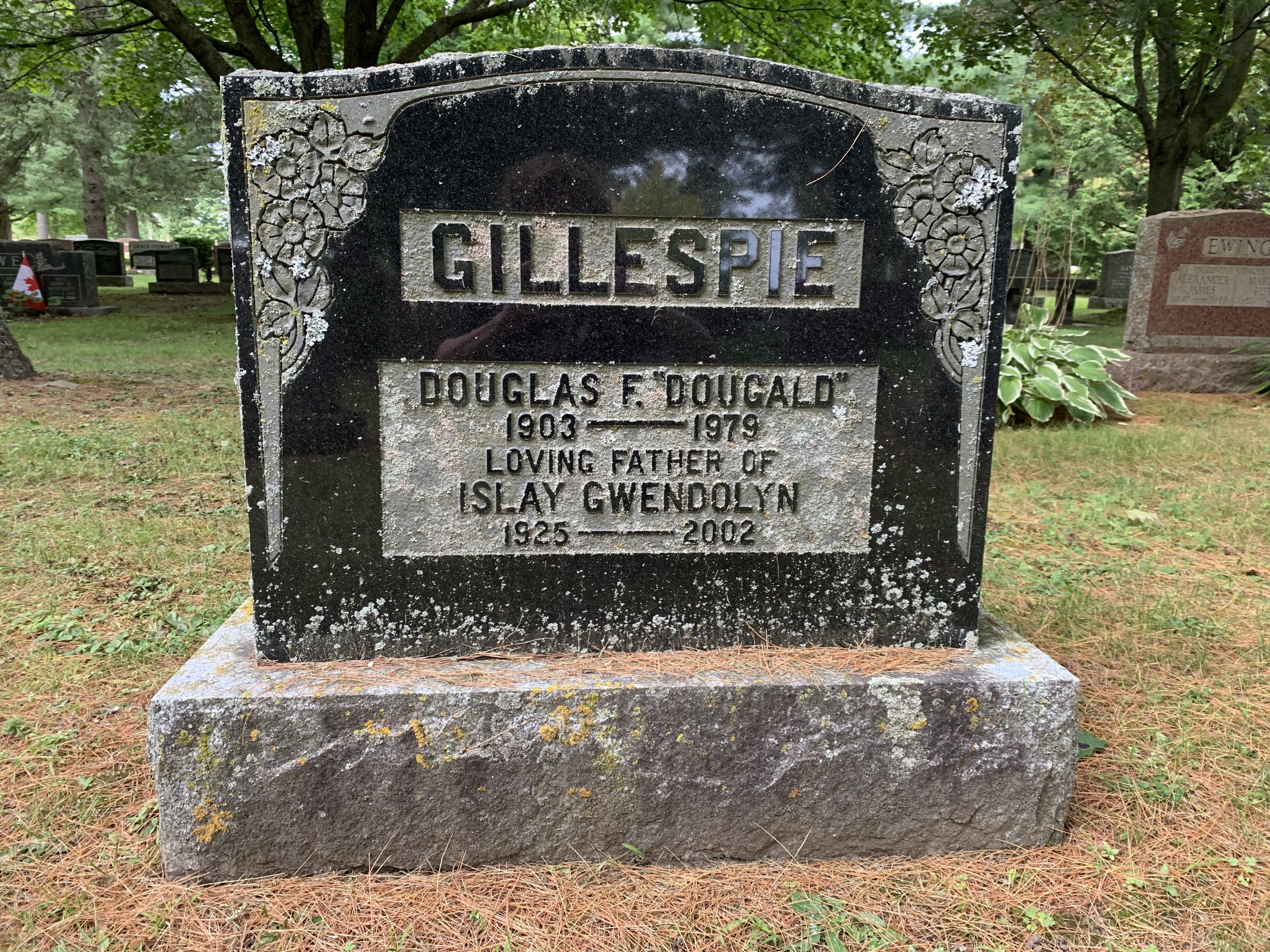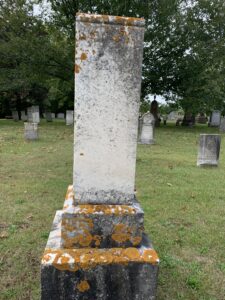I find cemeteries fascinating. Yes, there is a history of the people laying here, but at first it may not be known to you. Some communities or the cemetery may have produced publications about that history. Others have not. But cemeteries contain people who were community members sharing a period of time, a generation or so, often grouped together, with sons and daughters marrying their neighbours.
Remember this as you walk around wondering the connections. Notice the main names of other families. Occasionally the maiden name of the wife, a Gillespie, might be given on the stone, but it was not a common practice. A tremendous joy occurs when that stone lists the exact origin of the person buried. Yes, Ireland or Scotland helps, but I mean, the county, parish, the townland or village from where the person immigrated.

In Lindsay, I walked a cemetery with the gardener/staff who knew many of the Gillespies I had come to find. He told me stories that a tombstone could not.
I think of that moment on Wolfe Island after filming all the Gillespie tombstones, when I found Ann Gillespie Gillow’s white gravestone, stating she was from Co Armagh and her life dates: 1826 – 1868. This record fined tuned my research and bridged a gap I longed to know. A researcher of this family history later contacted me and we shared our knowledge together.
I was returning by ferry from Wolfe Island puzzled as where someone was buried I could not find. I chatted with the pilot, and he had worked with Robert Gillespie Jr, who lived on another nearby island with his family. This pilot knew the family well. I didn’t know Robert had been a ferry pilot. As the wind whipped my face and we crossed that open stretch of water, this man told me about Willowbank Cemetery in Gananogue, where other Gillespies were buried. Guess where I went as soon as I landed?
I even discovered that a Gillespie daughter, Elizabeth, had moved with her family to Northumberland County. I walked her farm one day, so far from the home turf in Frontenac County, and even further away across the ocean to Co Armagh, Ireland, which I visited in 2014.
What an honour to stand over a grave of a pioneer here in North America and then retrace their steps to the homeland and see the places they once loved, standing over the graves of their relatives. I was in awe in Scotland as I walked amongst the graves of those who were buried in the 1600s. The tombstones are still readable, standing proudly in white against the ravages of time.
In larger cemeteries one may find several generations buried here, sometimes interspersed, but frequently another community group, is located apart from another, but easily identified by colour of the tombstone.

Black tombstones have been common for some time now in Ontario cemeteries. This couple were my next door neighbours when I was growing up and represents that era of the early 1900 births. My Mom’s tombstone, in a nearby cemetery, is a black one as well as she was born in the early 1900s. Black stones belong to today. But they spread across a wide time-frame, especially of the 2000s.
Sometimes the stone is laid flat on the ground, less costly, but frequently seen with sod and grass creeping as a cover over the plate. It is hard to read an older flat stone for this reason. I never seem to remember to bring a tool with me to remove the sod. Wish cemetery staff would do that, but they usually are too busy. With the increase of cremations, there are now vaults in some cemeteries to provide a collection of people’s ashes with a frontal plate, to honour the dead.
 Red tombstones usually represent an earlier generation, often deaths in the late 1800s to early 1900s. Here is Gilbert Gillespie in the Beaverton Old Stone Church Cemetery with its many Isle of Islay Scottish settlers. Gilbert was a descendant. You may find some reddish coloured stone mingled with black stones today, since people can choose almost any colour they want, but it was not the situation in earlier times. Many of these reddish coloured stones had a tall spiral, and people used all sides of the stone to list names of people buried here. That is a less common practice today.
Red tombstones usually represent an earlier generation, often deaths in the late 1800s to early 1900s. Here is Gilbert Gillespie in the Beaverton Old Stone Church Cemetery with its many Isle of Islay Scottish settlers. Gilbert was a descendant. You may find some reddish coloured stone mingled with black stones today, since people can choose almost any colour they want, but it was not the situation in earlier times. Many of these reddish coloured stones had a tall spiral, and people used all sides of the stone to list names of people buried here. That is a less common practice today.
Not all names on the tombstone are necessarily buried here, as families did honour the memory of those who died far away. This is noted in both in Teeswater, Bruce County and in the cemeteries of Cannington. The family of Squire Malcolm Gillespie, a key Islay Scot, remembered his son, Dr Paul Gillespie, on the family tombstone. Paul had died in South Africa as a young man, having just married in 1916 and become a Justice of the Peace. In helping others he contacted and died of the dreaded plague.
 White stones are being erased by the winds of time. They are priceless treasures of the past. This is the tombstone of Duncan Gillespie in Beaverton Stone Cemetery, another Islay Scot. Although difficult to read from this photo, there are four sides that have been transcribed with details included elsewhere on this website under Ontario Deaths. Sometimes these white stones had no base, and are leaning as they weaken. But here is one with two bases, before the main tombstone placed on top. Size of tombstones in any era sometimes reflected the wealth of the family and were at times were flamboyant in display. An early collection of family burials might be surrounded by a metal fence, or put in a building, notably a Gillespie one in Huron County.
White stones are being erased by the winds of time. They are priceless treasures of the past. This is the tombstone of Duncan Gillespie in Beaverton Stone Cemetery, another Islay Scot. Although difficult to read from this photo, there are four sides that have been transcribed with details included elsewhere on this website under Ontario Deaths. Sometimes these white stones had no base, and are leaning as they weaken. But here is one with two bases, before the main tombstone placed on top. Size of tombstones in any era sometimes reflected the wealth of the family and were at times were flamboyant in display. An early collection of family burials might be surrounded by a metal fence, or put in a building, notably a Gillespie one in Huron County.
When you walk into a cemetery, pause and look around. See how the stones are grouped, and usually the oldest, white ones will stand out. Since they were the first graves in the cemetery, they may be close to the church or cemetery office. But that depends if it is the original building, or came much later in time.
Special markings on tombstones indicated membership in secret societies, such as the FreeMasons.

“Approximately 40-50% of all Americans belonged to fraternal organizations in the early 1900’s, and fraternal emblems are frequently included on monuments. Most common are Masonic and Order of the Eastern Star symbols. Others include the Odd Fellows Grand Army of the Republic, the Improved Order of Red Men (an offshoot of the Sons of Liberty) and numerous now-defunct, ethnic organizations such as German musical societies.”
Here is the most common Mason sign on a tombstone

Even today, people want to express their Christian faith and do so with the addition of a cross, angels or even a fish on the tombstone.
Some cemeteries gather all the old tombstones and present them in a circle or row for easy reading, and maybe grass cutting. Perhaps individually they were crumbling, and this way preserved them longer. These stones are no longer are on top of the grave of the person so named. It is so easy to drive by rapidly and miss the significance of a cemetery like this. I did myself, until I realized my great maternal grandparents were buried there in Simcoe County,
Some people have been buried in one cemetery, then interred and moved to another. I discovered this in Southern Ontario while hunting for a Gillespie cemetery that no longer exists except in name. I was trying to find the burials of the Gillespies who had fled the American Revolution. I left here and stopped in Niagara on the Lake to discover a very, very old Irish Gillespie burial near an oldest church in this historic town. This led to deeper research into the early military history of the area, and a visit to historic Queenston Heights in Hamilton. One visit so often propels one forward to other cemeteries and historic sites.
May I recommend that before going to any cemetery, first take a look on Find A Grave because not all burials have tombstones. Ask for information about the gravesite, because a listing from the office may reveal many others not yet known. Some cemeteries are less accommodating if they are busy with a funeral arrangement, so consider calling ahead to make an appointment. I usually try to give staff time to gather the information I have requested. But for many years I would just walk into the grounds, and try to figure things out for myself, and missed so much doing that. Often I would drive around in the car trying to spot a Gillespie tombstone The enjoyment is the mysteries yet to be solved in our search and the wonder of those that have been uncovered.
Sometimes a grave is just a grassy spot in a cemetery. That was all I saw when I first found my Dad’s grave finally. I dug up some corner stones that said “Gillespie.” Those foot stones mean a lot, as he died when I was nine years old. It is because of my love for my Dad that this website came into being, to honour him. Just a name on a stone and a gassy spot beside the cemetery road, but precious to me,
Secondly, see if the cemetery office will give you a listing of all burials of the people of your interest (I do it for all Gillespies and variant spellings of that name). Some may already be online, which you can print off before you arrive. The cemetery listing will normally include the grave identification, but you have to figure that out, as it is different for every place. So get a map of the cemetery to go with the listing of names, so you can walk through the grounds and discover so much.
Some cemeteries have special burial locations for the military war dead or tragic events. In my home cemetery is the lovely tombstone for a little girl who died in the 1950s from a tornado that came through our area. Who was she, I wondered. There were also markers for babies of the family next door, hinting of an early tragedy in their lives that I knew nothing of, Part of their family history and suffering of long ago.
I have already mentioned elsewhere my fascination with the Titanic burials that I visited in the Maritimes. Just like many of them who remain unknown, so many people in graves will never be identified. Think of the suffering of their families. I hold Ireland’s government gravely responsible for letting many of its cemetery staff bury its residents without full identification. What about those in war-torn situation, like Ukraine, where bodies are dumped in unmarked mass burials to hide them. There may be millions of people whose families today cannot find them because their grave is not identified.
Thankfully, here in Canada, that is not so. One can get an emotional response when visiting a cemetery, It may or may not be personal grief. It can be for the suffering of others. Usually for me it is a sense of tranquility. I have even enjoyed watching deer grazing among the tombs, who were startled to see me, or maybe a rabbit hops by. In a world of strife, I have found cemeteries to be a calming influence on my own emotions. A place for tears sometimes, or quiet contemplation. Here is a poem to help express those feelings.
by Patricia A Fleming
I took a walk this morning
Just as the sun began to rise,
And the inky clouds encompassed her
And cluttered up the skies.
In the gloom I stood among
Those worn and weathered stones.
Stretched out upon the greenest grass
Each standing quite alone.
A morning bird was singing
Such a sweet and mournful song,
A tribute to those dearest souls
Who long ago moved on.
Ancient trees stood towering
Like loyal sentries standing guard,
Witnesses to all those laid to rest
And those surviving broken hearts.
The respectful silence floated
On a chilly morning breeze,
And the peacefulness embraced me
Like a blanket warming me.
Outside the gates, life carried on,
A siren pierced the hallowed air.
I thought perhaps another soul
Would soon be buried there.
I strolled around quite aimlessly
Entranced by all those words in stone,
And I realized that behind those words
Each had a story of their own.
I was glad I came to visit them
On this dark and dreary day,
And shared my story with them too
As I wandered on my way.
And as I reached the gates to leave,
Rain fell lightly from the sky,
And I swear I heard the softest voice
Bidding me a sweet good-bye.

![]()

I’m a Gillespie from Ogdensburg New York. My mother was a Lesperances born and raised there.She now is buried in Notre Dame Catholic Cemetery with her parents. You are doing a great job visiting all the cemeteries. Just wanted to thank you.